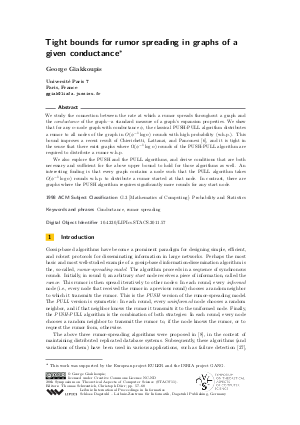Tight bounds for rumor spreading in graphs of a given conductance
Author George Giakkoupis
-
Part of:
Volume:
28th International Symposium on Theoretical Aspects of Computer Science (STACS 2011)
Part of: Series: Leibniz International Proceedings in Informatics (LIPIcs)
Part of: Conference: Symposium on Theoretical Aspects of Computer Science (STACS) - License:
 Creative Commons Attribution-NonCommercial-NoDerivs 3.0 Unported license
Creative Commons Attribution-NonCommercial-NoDerivs 3.0 Unported license
- Publication Date: 2011-03-11
File

PDF
LIPIcs.STACS.2011.57.pdf
- Filesize: 0.61 MB
- 12 pages
Document Identifiers
Subject Classification
Keywords
- conductance
- rumor spreading
Metrics
- Access Statistics
-
Total Accesses (updated on a weekly basis)
0Document
0Metadata
Abstract
We study the connection between the rate at which a rumor spreads throughout a graph and the conductance of the graph -- a standard measure of a graph's expansion properties. We show that for any n-node graph with conductance phi, the classical PUSH-PULL algorithm distributes a rumor to all nodes of the graph in O(phi^(-1) log(n)) rounds with high probability (w.h.p.). This bound improves a recent result of Chierichetti, Lattanzi, and Panconesi [STOC 2010], and it is tight in the sense that there exist graphs where Omega(phi^(-1)log(n)) rounds of the PUSH-PULL algorithm are required to distribute a rumor w.h.p. We also explore the PUSH and the PULL algorithms, and derive conditions that are both necessary and sufficient for the above upper bound to hold for those algorithms as well. An interesting finding is that every graph contains a node such that the PULL algorithm takes O(phi^(-1) log(n)) rounds w.h.p. to distribute a rumor started at that node. In contrast, there are graphs where the PUSH algorithm requires significantly more rounds for any start node.
Cite As Get BibTex
George Giakkoupis. Tight bounds for rumor spreading in graphs of a given conductance. In 28th International Symposium on Theoretical Aspects of Computer Science (STACS 2011). Leibniz International Proceedings in Informatics (LIPIcs), Volume 9, pp. 57-68, Schloss Dagstuhl – Leibniz-Zentrum für Informatik (2011)
https://doi.org/10.4230/LIPIcs.STACS.2011.57
BibTex
@InProceedings{giakkoupis:LIPIcs.STACS.2011.57,
author = {Giakkoupis, George},
title = {{Tight bounds for rumor spreading in graphs of a given conductance}},
booktitle = {28th International Symposium on Theoretical Aspects of Computer Science (STACS 2011)},
pages = {57--68},
series = {Leibniz International Proceedings in Informatics (LIPIcs)},
ISBN = {978-3-939897-25-5},
ISSN = {1868-8969},
year = {2011},
volume = {9},
editor = {Schwentick, Thomas and D\"{u}rr, Christoph},
publisher = {Schloss Dagstuhl -- Leibniz-Zentrum f{\"u}r Informatik},
address = {Dagstuhl, Germany},
URL = {https://drops.dagstuhl.de/entities/document/10.4230/LIPIcs.STACS.2011.57},
URN = {urn:nbn:de:0030-drops-29977},
doi = {10.4230/LIPIcs.STACS.2011.57},
annote = {Keywords: conductance, rumor spreading}
}
